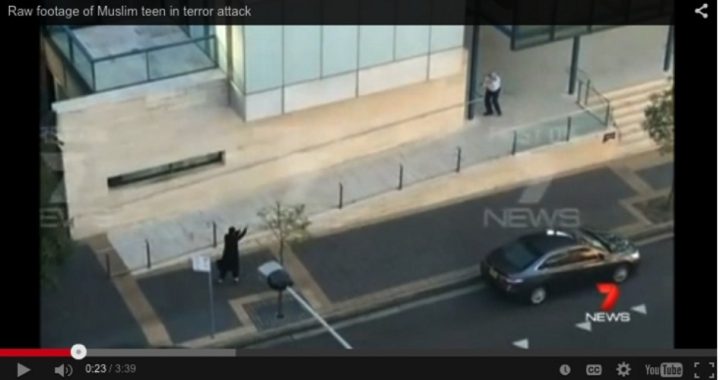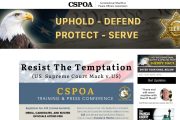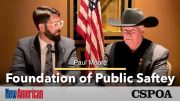
Following the deliberate, cold-blooded murder of a Sydney, Australia police force employee by a 15-year-old jihadi last Friday, local authorities have been trying to find the answers to many questions.
On Friday afternoon, 4:30 p.m. local time, Farhad Jabar Khalil Mohammad, dressed in Islamic garb, walked up behind Curtis Cheng as he was leaving police headquarters in Parramatta on Sydney’s west side, pointed his handgun at the back of Cheng’s head, and squeezed the trigger. Cheng was dead before his body hit the ground. The teen then danced a jig in the street, shouting “Allahu Akbar!” Constables from headquarters who rushed outside found themselves targeted by the teen before they returned fire, killing the assassin.
The investigation, which is ongoing, determined that the youth, a student at a nearby high school, had no criminal record and was not under suspicion by the police. His parents were Iraqi Kurds, although the killer was born in Iran. Officers learned that he had just come from Friday prayers at a local mosque and concluded that his actions “were politically motivated and therefore linked to terrorism,” adding that “we have no information that this individual posed this kind of threat but we will investigate thoroughly.”
One of the key questions those investigators will no doubt consider is: Where did he get a handgun in “gun-free” Australia? Didn’t Australia ban most civilian semi-automatic weapons and pistols back in 1996 — banned generally except for people such as security personnel, who must show that they’ve taken classes before getting a very rare permit? Didn’t Australia institute a mandatory “gun buyback” program that removed upwards of a million guns from their rightful owners? Didn’t Australia enact the laws that gun controllers want in the United States: Universal gun registration, few semi-automatic weapons, gun confiscation — going so far as to restrict air guns?
That’s the same question investigators faced back in December when Man Haron Monis, bearded and wearing a black headband with the inscription in Arabic “We are ready to sacrifice for you, O Mohammad,” entered the Lindt Chocolate Café in Sydney and, waving a shotgun, took 18 people hostage. Monis had been diagnosed with schizophrenia, had been accused as an accessory in his wife’s murder, and hadn’t obtained a gun license. The standoff lasted for 16 hours before Monis was subdued and killed by police.
Where did he get his shotgun? Why didn’t the laws stop him?
Adding to the confusion, during their investigation, officers learned that Monis was out on bail at the time, having been previously convicted of numerous crimes and offenses.
When New South Wales Premier Mike Baird learned of the murder of Cheng in Sydney on Friday, he had his own questions: “How can someone so young undertake such a chilling act? It doesn’t make sense. It should never have happened. Obviously we are all lost for words.”
Never at a loss for words when there’s a shooting, President Obama lamented a U.S. massacre at Umpqua Community College in Oregon last week:
As I said just a few months ago, and I said a few months before that, and I said each time we see one of these mass shootings, our thoughts and prayers are not enough.
It’s not enough. Somehow this has become routine. The reporting is routine. My response here at this podium ends up being routine.
We know that other countries, in response to one mass shooting, have been able to craft laws that almost eliminate mass shootings. Friends of ours, allies of ours — Great Britain, Australia, countries like ours.
So we know there are ways to prevent it.
The president noticeably didn’t mention the failure of Australia’s gun laws to prevent the hostage situation in Sydney last December. And of course he hasn’t come forth with any explanation about how the shooter last Friday came by his handgun in the “gun-free” country of Australia that he wants the United States to emulate.
The differences between Australia and the United States could scarcely be greater. The United States fought against Great Britain to gain its independence, using guns in the hands of its citizens. Australia assented to its independence in 1931 through the gift of the British Parliament, called the Statute of Westminster. Accordingly there is nothing in Australia’s founding documents equivalent to the Second Amendment, and there is little in the country’s culture that recognizes the need for firearms in the hands of its citizens to guard against governmental tyranny.
That explains why Aussies were willing, with little resistance, to give up nearly one million of their firearms under the government-mandated gun buyback program launched on October 1, 1996 and concluded a year later. Adding insult to injury, the buyback was funded by a tax on the very citizens whose rights were being violated.
On the other hand, the freedom culture in America remains vibrant. And this has caused massive noncompliance in New York and Connecticut when those states passed laws infringing on precious rights guaranteed under the Second Amendment. Bob Owens, writing in his Bearing Arms blog, knows there’s little that officials in those states can do about it:
New York and Connecticut authorities so far have shown no inclination to enforce their laws by going door to door to round up unregistered guns and arrest their owners.
But that’s what would be necessary to enforce the law.
A federal law [mandating gun confiscation] would require sweeping, national police action involving thousands of lawmen and affecting tens of millions of people.
If proponents of gun control are serious about getting guns out of Americans’ hands, someone will have to take those guns out of Americans’ hands.
Verad Mehta, a noted American history scholar writing at The Federalist, asked perhaps the most profoundly important question of all:
Gun confiscation is not happening in the United States any time soon. But let’s suppose it did. How would it work?
Australia’s program netted, at the low end, 650,000 guns, and at the high end, a million. That was approximately a fifth to a third of Australian firearms.
There are about as many guns in America as there are people: 310 million of both in 2009. A fifth to a third would be between 60 and 105 million guns. To achieve in America what was done in Australia, in other words, the government would have to confiscate as many as 105 million firearms….
How do you take 60 to 105 million firearms from 105 to 160 million Americans?
He added:
Let there be no doubt. Gun confiscation would have to be administered by force of arms. I do not expect that those who dismissed their fellow citizens for clinging bitterly to their guns are so naïve that they imagine these people will suddenly cease their bitter clinging when some nice young man knocks on their door and says, “Hello, I’m from the government and I’m here to take your guns.”
Yet only a militarized police could enforce an Australian gun-control scheme in the United States.
To take arms from men requires men with arms. There’s no other way to do it….
To choose Australia is to choose civil war.
It would be wise for the president to recognize that America is not Australia, much as he would like it to be. If he presses the matter, American citizens will no doubt opt to continue to cling to their guns and their rights under the Second Amendment.
A graduate of an Ivy League school and a former investment advisor, Bob is a regular contributor to The New American magazine and blogs frequently at www.LightFromTheRight.com, primarily on economics and politics.



